-
REVIEW07-29-2024
Utilization of local pressure devices in pain management during injections: scoping review
Revista Brasileira de Enfermagem. 2024;77(3):e20230399
Abstract
REVIEWUtilization of local pressure devices in pain management during injections: scoping review
Revista Brasileira de Enfermagem. 2024;77(3):e20230399
DOI 10.1590/0034-7167-2023-0399
Views0See moreABSTRACT
Objective:
to map scientific evidence regarding the use of local pressure devices in pain relief during injection procedures in patients.
Methods:
scoping review, following the recommendations of the JBI Manual for Evidence Synthesis and PRISMA-ScR, with searches conducted in the PubMed, EMBASE, CINAHL, LILACS, and PsycINFO databases, without temporal restrictions and with a cutoff date of March 2023.
Results:
a total of 1,514 studies were identified, with 20 articles included in the final sample. The ShotBlocker® device was utilized during subcutaneous and intramuscular injections in children and adults, proving beneficial in reducing pain, anxiety, and fear associated with the procedure.
Final considerations:
the ShotBlocker® is a low-cost, easy-to-use device that can enhance nursing clinical practice during painful procedures. However, studies involving the Brazilian Pikluc® device are scarce. Further research involving both local pressure devices is recommended.
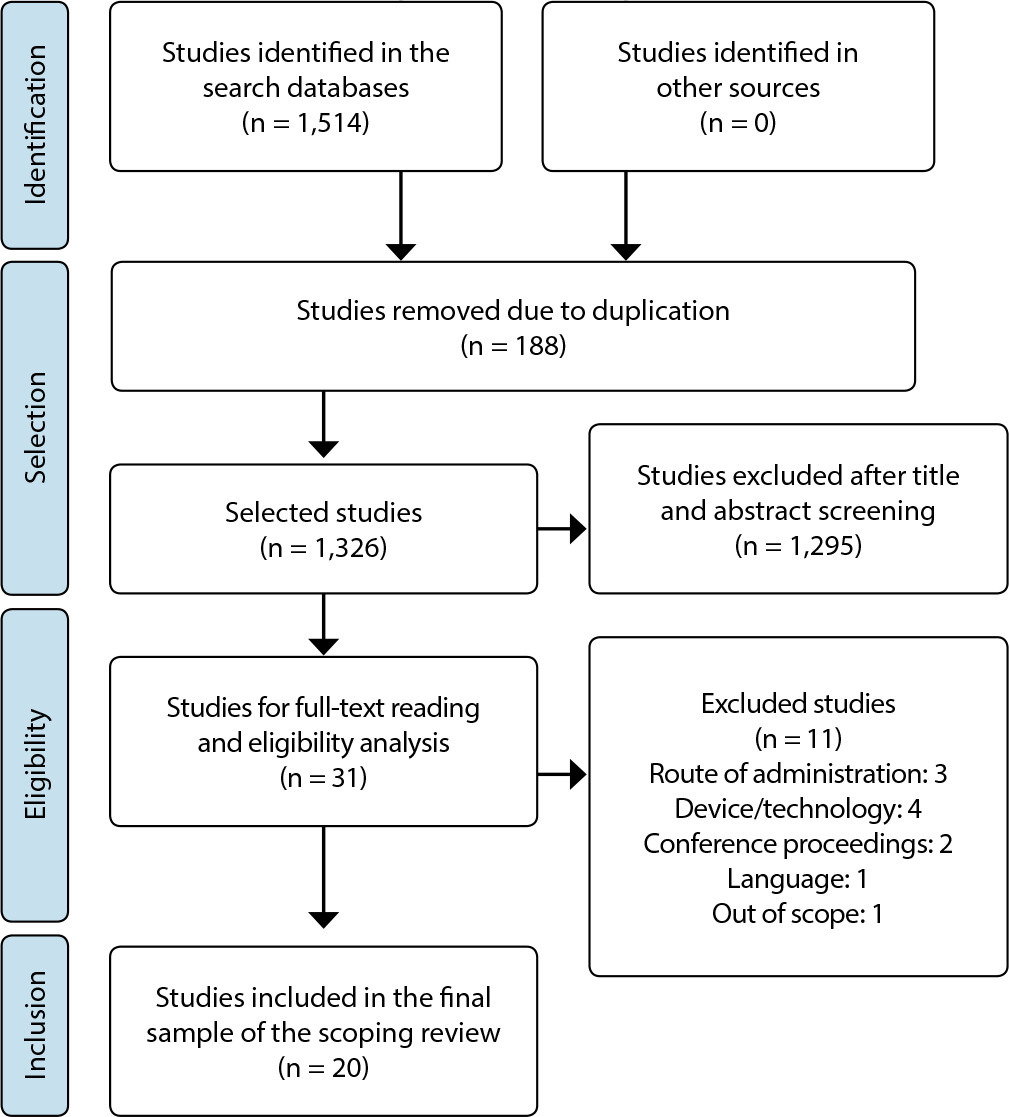
-
ORIGINAL ARTICLE07-29-2024
Sexual counseling for people with acute coronary syndrome: educational video development
Revista Brasileira de Enfermagem. 2024;77(3):e20230416
Abstract
ORIGINAL ARTICLESexual counseling for people with acute coronary syndrome: educational video development
Revista Brasileira de Enfermagem. 2024;77(3):e20230416
DOI 10.1590/0034-7167-2023-0416
Views0See moreABSTRACT
Objective:
to assess validity evidence of an educational video on safe sexual activity after acute coronary syndrome.
Method:
study in three phases: video development; content validity analysis by 11 experts; and analysis of validity based on response processes by seven people with coronary disease. The content validity ratio (CVR) was calculated with critical values for the second phase of 0.63 and for the third of 1.0.
Results:
the video addressed the importance of resuming sexual activity and positions that consume less energy, clinical warning signs, the importance of adhering to treatment and a welcoming environment for sexual practice. A CVR above the critical value was obtained with a total of 4 minutes and 41 seconds.
Conclusion:
the educational video brings together adequate content validity evidence and can be used as a tool for patients after acute coronary syndrome.
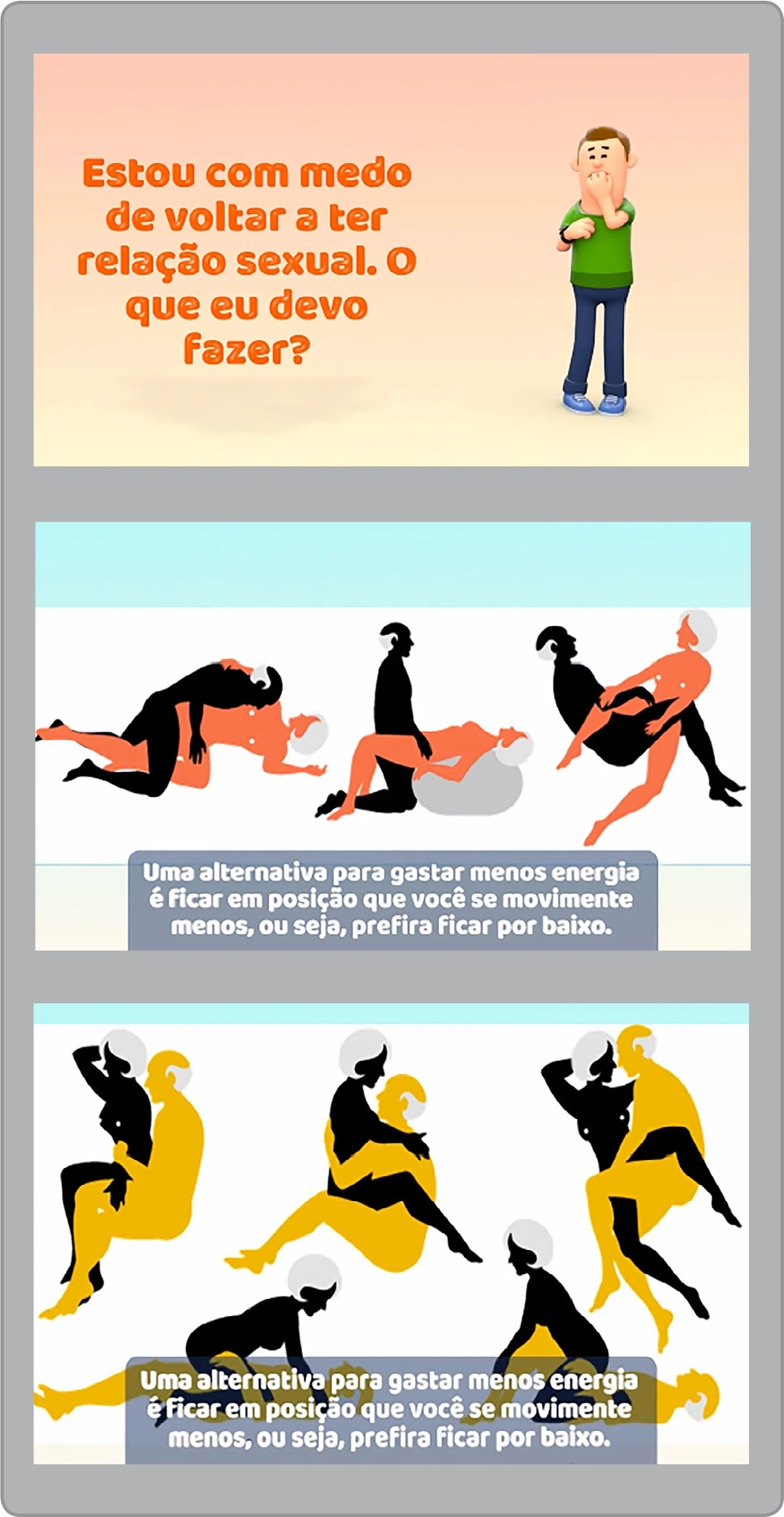
-
ORIGINAL ARTICLE07-19-2024
The use of spirituality/religiosity by oncology nurse residents in nursing care
Revista Brasileira de Enfermagem. 2024;77(2):e20230383
Abstract
ORIGINAL ARTICLEThe use of spirituality/religiosity by oncology nurse residents in nursing care
Revista Brasileira de Enfermagem. 2024;77(2):e20230383
DOI 10.1590/0034-7167-2023-0383
Views1See moreABSTRACT
Objectives:
to analyze the use of spirituality/religiosity by oncology nurse residents in caring for patients with cancer.
Methods:
a census, descriptive, sectional study, with 46 nurse residents from three public hospitals in Rio de Janeiro. Data collection took place between August 2020 and January 2021, using a sociodemographic questionnaire, including a question about the use of spirituality/ religiosity to deal with work situations. Descriptive analysis was carried out using SPSS software version 22.0.
Results:
participants stated that they use religiosity/spirituality in work situations related to patients or themselves. In relation to patients, death was the most mentioned situation among professionals, and for themselves, everyday situations and emotional vulnerability were the most mentioned.
Final Considerations:
spirituality and religiosity are dimensions that guide oncology nurse residents’ attitudes.
-
ORIGINAL ARTICLE07-19-2024
Translation and cross-cultural adaptation of the MISSCARE Survey-Ped into Brazilian Portuguese
Revista Brasileira de Enfermagem. 2024;77(2):e20230060
Abstract
ORIGINAL ARTICLETranslation and cross-cultural adaptation of the MISSCARE Survey-Ped into Brazilian Portuguese
Revista Brasileira de Enfermagem. 2024;77(2):e20230060
DOI 10.1590/0034-7167-2023-0060
Views0See moreABSTRACT
Objectives:
to translate and cross-culturally adapt the MISSCARE Survey-Ped for use in Brazil.
Methods:
a methodological study proposed by translation, synthesis of translations, back-translation, assessment by a committee of experts and pre-testing with the target population.
Results:
two direct translations of the instrument were carried out, followed by a consensual version between them. This synthetic version was back-translated and analyzed by a committee of five experts in pediatric nursing and patient safety, obtaining a Content Validity Index (CVI) of 0.95 and Cronbach’s alpha of 0.804. The final version was sent for pre-testing with 254 Brazilian pediatric nurses, with 44 (17.3%) analyzing the instrument for understanding (CVI 0.866; Content Validity Ratio (CVR) 0.773), relevance (CVI 0.931; CVR 0.864) and relevance (CVI 0.977; CVR 0.955).
Conclusions:
the MISSCARE Survey-Ped Brasil was considered suitable for application in pediatric nurses’ clinical practice in the country.
-
REVIEW07-19-2024
Drug-resistant tuberculosis: integrative review of nursing care in primary health care
Revista Brasileira de Enfermagem. 2024;77(2):e20230097
Abstract
REVIEWDrug-resistant tuberculosis: integrative review of nursing care in primary health care
Revista Brasileira de Enfermagem. 2024;77(2):e20230097
DOI 10.1590/0034-7167-2023-0097
Views0See moreABSTRACT
Objectives:
to identify, in the scientific literature, the care that should be provided to individuals with drug-resistant tuberculosis by nurses in primary health care.
Methods:
integrative review, using the Preferred Reporting Items for Systematic Reviews and Meta-Analyses study selection flowchart. Data collection was conducted in November 2022, across ten databases.
Results:
six studies emphasized that nurses should perform directly observed treatment; two highlighted the importance of integrated care management between tuberculosis and human immunodeficiency virus; two demonstrated comprehensive nursing consultation using the nursing process; one emphasized person-centered care, with discharge planning and improved hospital communication with primary health care services.
Final Considerations:
the care that nurses should provide to individuals with drug-resistant tuberculosis in primary health care, for care resolution, is evidence-based.
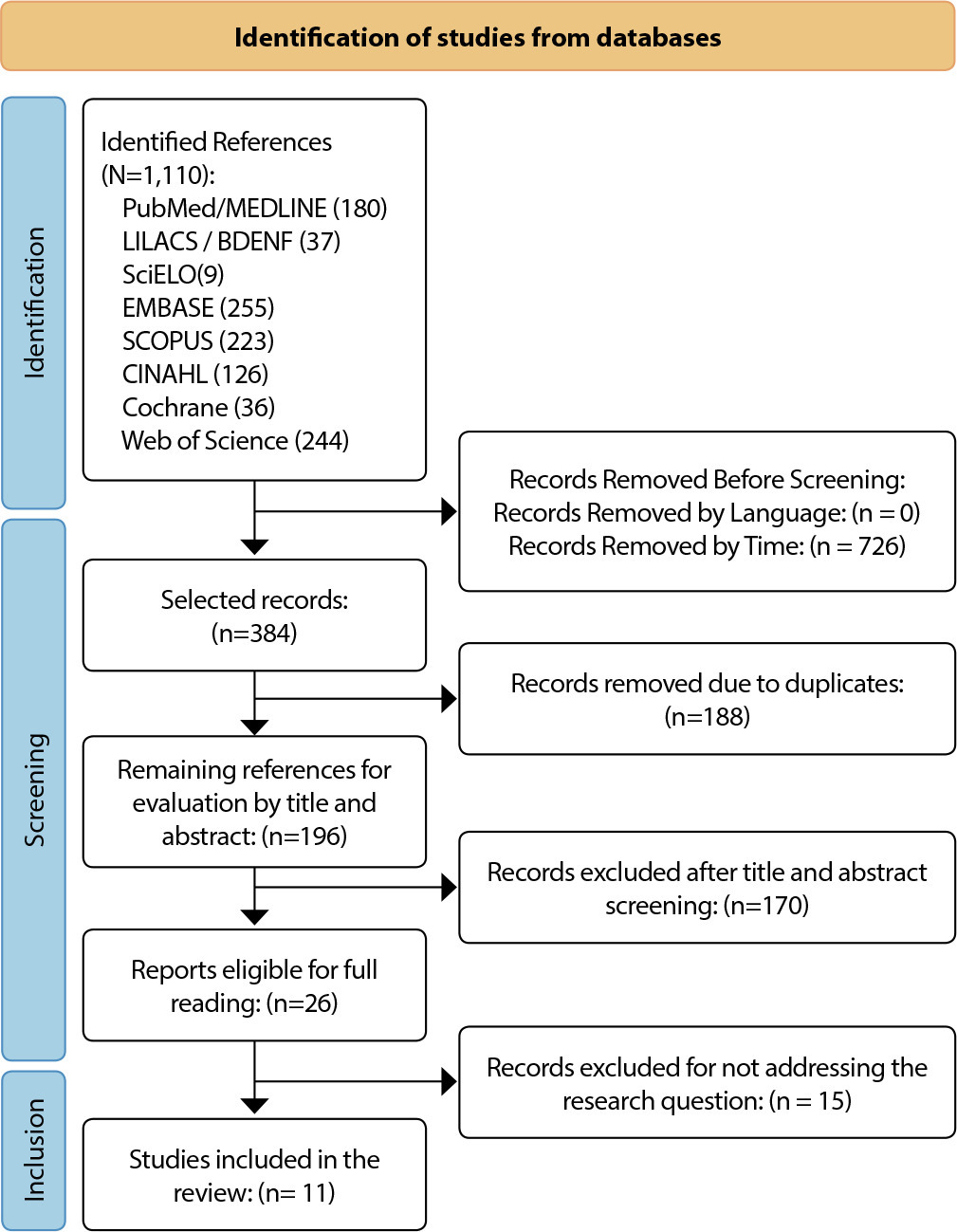
-
ORIGINAL ARTICLE07-19-2024
Understanding intimate self-care among riverine women: qualitative research through the lens of the Sunrise Model
Revista Brasileira de Enfermagem. 2024;77(2):e20230364
Abstract
ORIGINAL ARTICLEUnderstanding intimate self-care among riverine women: qualitative research through the lens of the Sunrise Model
Revista Brasileira de Enfermagem. 2024;77(2):e20230364
DOI 10.1590/0034-7167-2023-0364
Views0See moreABSTRACT
Objectives:
to contribute to the change in understandings and knowledge of the popular system among riverine women about female intimate self-care before and after the application of an educational dynamic.
Methods:
a qualitative-participative study based on the Sunrise Model. Twenty women registered at a Basic Health Unit on the Combu island, state of Pará, Brazil, participated in the second half of 2022. Semi-structured interviews were conducted before and after the educational dynamic; followed by reflective inductive analysis.
Results:
these are pointed out: a female mechanism of generational education; the cultural act of bathing as synonymous with intimate self care and disease prevention; intimate care with medicinal herbs; lack of professional system approach to the topic; fear of using “muddy water”; and lack of financial resources to purchase specific products for genitourinary care.
Final Considerations:
companionship and social factors drive intimate self-care; however, riverine women experience taboos, ignorance, and poverty.
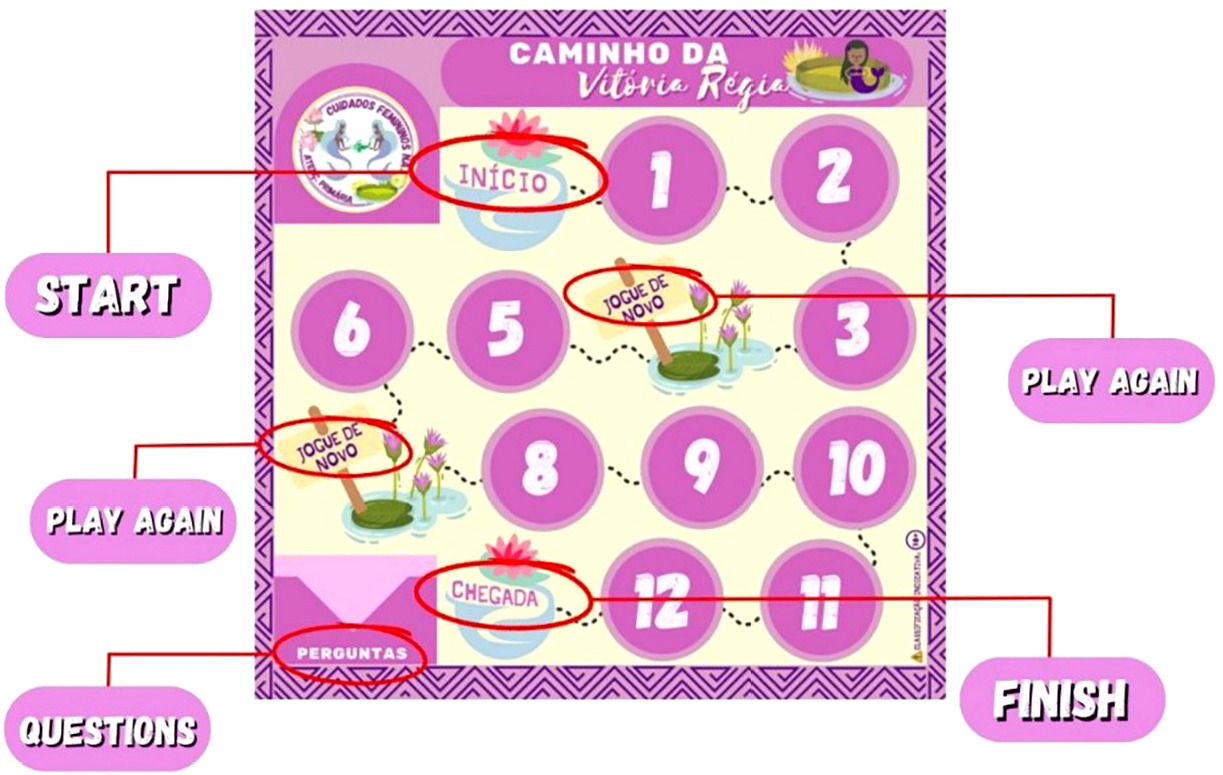
-
ORIGINAL ARTICLE07-19-2024
Validation of an instrument for assessing leprosy care in children and adolescents
Revista Brasileira de Enfermagem. 2024;77(2):e20230344
Abstract
ORIGINAL ARTICLEValidation of an instrument for assessing leprosy care in children and adolescents
Revista Brasileira de Enfermagem. 2024;77(2):e20230344
DOI 10.1590/0034-7167-2023-0344
Views1See moreABSTRACT
Objectives:
to validate the content of an instrument for assessing leprosy care in individuals under 15 years old in the context of Primary Health Care.
Methods:
methodological study of content validation, based on the evaluation of essential and derived attributes in primary care, in the professional version. For data analysis, the Content Validation Index (CVI ≥ 0.8) and Cronbach’s Alpha were calculated.
Results:
a higher percentage of judges among nurses (61.5%) was observed; with a doctorate (46.2%), and engaged in teaching and research (77%). The overall Content Validation Index of the instrument was 0.98. In the analysis of Cronbach’s Alpha of the instrument, the assigned value was 0.717.
Conclusions:
the instrument represents an advancement in the measurement of health evaluation policies and can significantly contribute to improving the quality of care provided to children and adolescents with leprosy.
-
ORIGINAL ARTICLE07-19-2024
Validation of an instrument for patient classification to support obstetric nursing care
Revista Brasileira de Enfermagem. 2024;77(2):e20230401
Abstract
ORIGINAL ARTICLEValidation of an instrument for patient classification to support obstetric nursing care
Revista Brasileira de Enfermagem. 2024;77(2):e20230401
DOI 10.1590/0034-7167-2023-0401
Views0See moreABSTRACT
Objectives:
to develop and validate an instrument for the classification of pregnant and postpartum women according to the demand for nursing care.
Methods:
a methodological study conducted in three stages: 1) construction of the instrument based on literature review; 2) content validation using the Delphi technique with 12 experts; and 3) Evaluation of the convergent construct validity through the correlation between the scores of the constructed instrument and the Fugulin instrument.
Results:
an instrument with ten indicators of specific care for pregnant and postpartum women was developed. A content validity index higher than 0.9 was obtained, requiring only one round of the Delphi technique. The Spearman coefficient was 0.64 between the instruments, indicating a strong correlation.
Conclusions:
the classification instrument specifically constructed for pregnant and postpartum women showed evidence of content validity and convergent construct validity with a widely used instrument in the national territory.
-
REVIEW07-31-2020
Educational practices for families of children and adolescents using a permanent venous catheter
Revista Brasileira de Enfermagem. 2020;73:e20190129
Abstract
REVIEWEducational practices for families of children and adolescents using a permanent venous catheter
Revista Brasileira de Enfermagem. 2020;73:e20190129
DOI 10.1590/0034-7167-2019-0129
Views0See moreABSTRACT
Objectives:
to identify, in the scientific literature, the educational practices performed by nurses with the families of children and adolescents using long-term venous catheters, concerning home care.
Methods:
integrative review in LILACS, PubMed, SCOPUS, Web of Science and CINAHL databases, from August to September 2018.
Results:
we analyzed eight articles that met the inclusion criteria. The results showed that all studies are international, mostly North American and with low level of evidence. The educational practices found were home visits, production of printed educational materials, use of mannequins for simulation, creation of an educational video, and combined educational practices.
Final Considerations:
the care provided by families at home in the countries studied is more complex than in Brazil, and the conclusion is that Brazilian studies need to advance in publications related to this area.
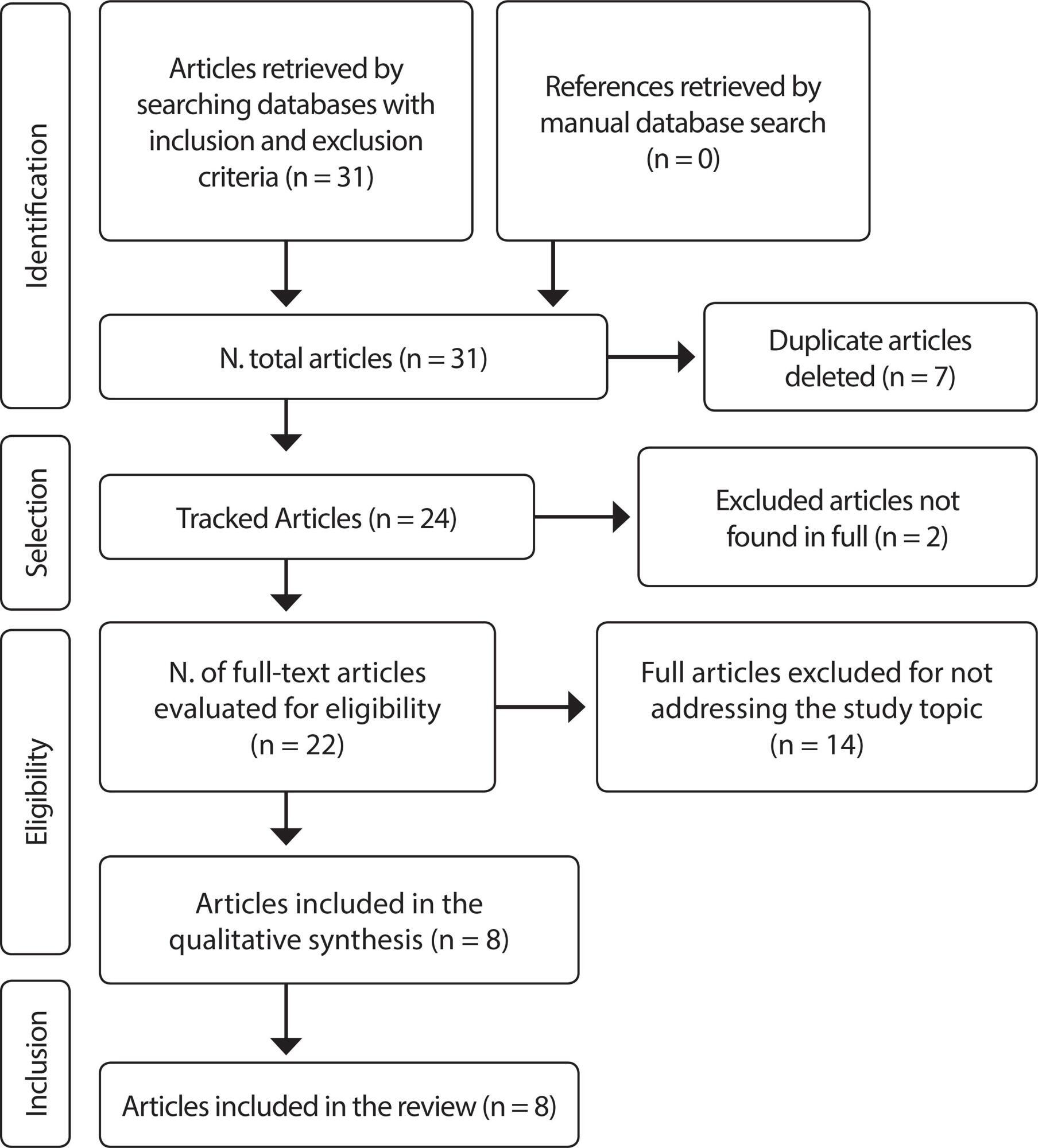
-
REVIEW07-17-2020
Approaches to workload in psychiatric and mental health nursing
Revista Brasileira de Enfermagem. 2020;73:e20190620
Abstract
REVIEWApproaches to workload in psychiatric and mental health nursing
Revista Brasileira de Enfermagem. 2020;73:e20190620
DOI 10.1590/0034-7167-2019-0620
Views0See moreABSTRACT
Objective:
to investigate approaches to workload in psychiatric and mental health nursing in Brazilian and international production of knowledge
Methods:
integrative literature review using six databases, covering January 2005 to March 2019. Articles in full in English, Spanish and Portuguese were included.
Results:
the sample consisted of 23 original articles classified as quantitative or emotional. The quantitative dimension was addressed in 12 articles and included: assessing patient care needs, identifying activities performed by the team, measuring time spent and developing and validating a measurement instrument. The emotional dimension included 11 articles the focus of which was on identifying stressors in the workplace, psychosocial risks and coping strategies.
Conclusion:
strategies were found for measuring workload and assessing the impact of stressors on nursing teams.
-
ORIGINAL ARTICLE10-19-2020
Problematization educational intervention to promote healthy habits in elderly people with diabetes: randomized clinical trial
Revista Brasileira de Enfermagem. 2020;73:e20190719
Abstract
ORIGINAL ARTICLEProblematization educational intervention to promote healthy habits in elderly people with diabetes: randomized clinical trial
Revista Brasileira de Enfermagem. 2020;73:e20190719
DOI 10.1590/0034-7167-2019-0719
Views0See moreABSTRACT
Objective:
to assess the effects of a problematization educational intervention to promote healthy habits in elderly people with diabetes.
Methods:
a randomized clinical trial conducted with 202 individuals drawn for the intervention group and the control group. The intervention consisted of problematization educational activities on a monthly basis for over six months. The control group participated in conventional monitoring at the health unit. Data were collected through semi-structured interviews before and after the intervention, in addition to laboratory tests.
Results:
after the intervention, when compared to the control group, there was an increase in knowledge about the disease (p<0.001), positive attitude towards self-care (p=0.011), physical activity (p=0.020), diet variety (p=0.002), and lower consumption of oils and fats (p<0.05).
Conclusion:
the intervention performed has a beneficial effect to promote healthy habits.
-
ORIGINAL ARTICLE10-23-2020
Active ageing among elderly community members: structural equation modeling analysis
Revista Brasileira de Enfermagem. 2020;73:e20200110
Abstract
ORIGINAL ARTICLEActive ageing among elderly community members: structural equation modeling analysis
Revista Brasileira de Enfermagem. 2020;73:e20200110
DOI 10.1590/0034-7167-2020-0110
Views0See moreABSTRACT
Objective:
to propose a structural model of active ageing among elderly community members based on the World Health Organization’s theoretical framework and to identify the most relevant determinants of active ageing to the proposed model.
Methods:
a cross-sectional and analytical study conducted with 957 elderly community members. Confirmatory factor analysis and structural equation modeling were performed.
Results:
the final measurement model was composed of the six determinants of active ageing: behavioral (R²=0.66); personal (R²=0.74); physical environment (R²=0.70); social (R²=0.77); economic (R²=0.44); and social and health services (R²=0.95). The last one showed good quality of adjustment: χ2/gl=3.50; GFI=0.94; CFI=0.92; TLI=0.90; RMSEA=0.05. By analyzing the trajectories between determinants and active ageing, the most representative was social and health services active ageing (λ=0.97; p<0.001).
Conclusion:
satisfaction with access to health services and positive self-assessment of health status were the factors that most contributed to active ageing in this population.
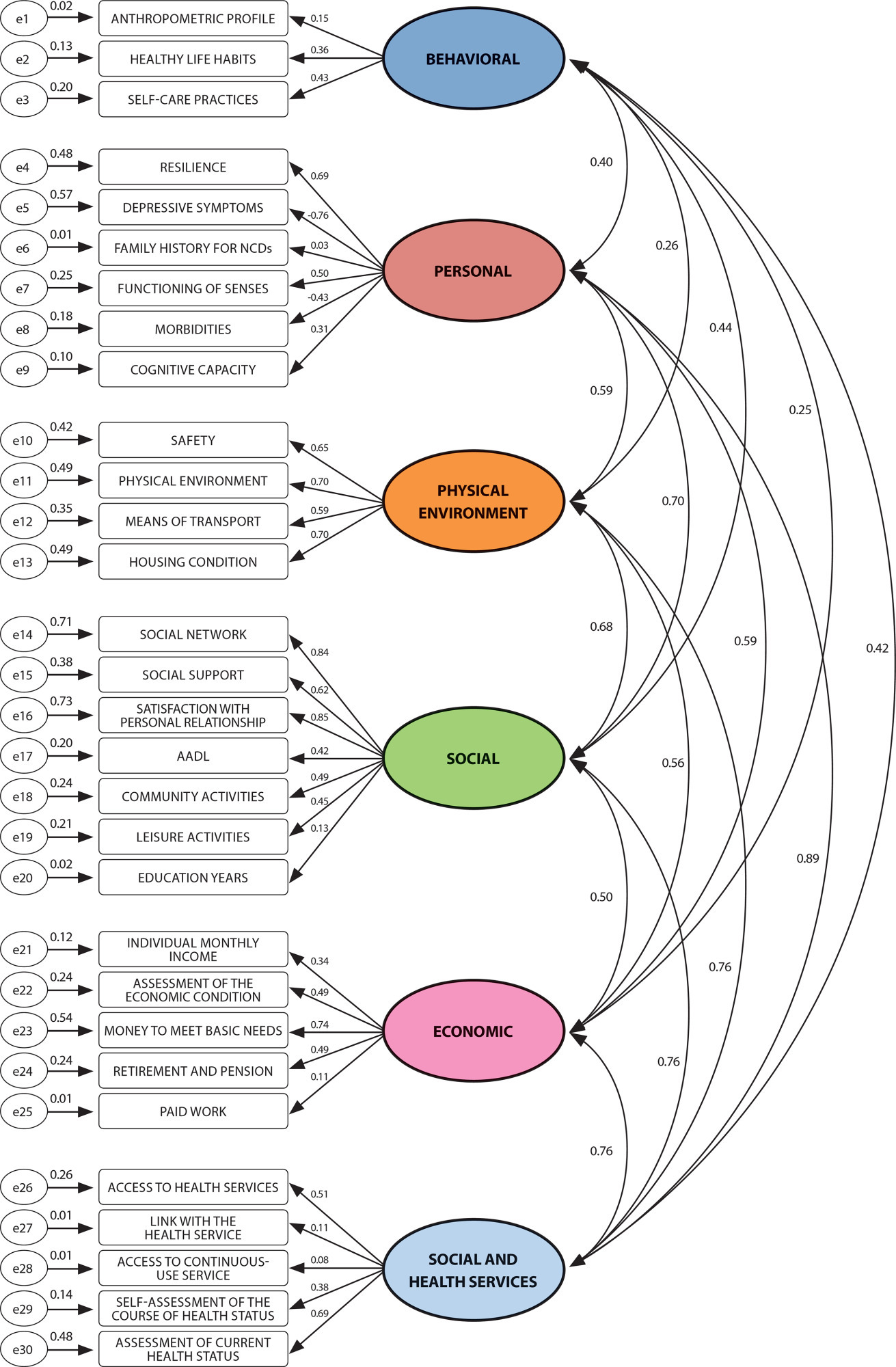
-
ORIGINAL ARTICLE05-28-2021
Nurses’ educational practices in Family Health Strategy
Revista Brasileira de Enfermagem. 2021;74(2):e20200045
Abstract
ORIGINAL ARTICLENurses’ educational practices in Family Health Strategy
Revista Brasileira de Enfermagem. 2021;74(2):e20200045
DOI 10.1590/0034-7167-2020-0045
Views0See moreABSTRACT
Objectives:
to analyze the nurse’s educational practice in Family Health Strategy.
Methods:
descriptive study with a qualitative approach, whose data production used the World Café group technique, in two meetings, with 26 nurses of a health district of Manaus-AM. The technique used was Categorial-Thematic Content Analysis.
Results:
the study generated two units of analysis: Political and Organizational Configuration of Educational Work at ESF and Operational Configuration of Educational Work at ESF, revealing the necessary (re)configurations in co-management, in the centrality of the subject for the planning of educational work, and in (re)pactuation between the management of services and training institutions to overcome contradictions in the implementation of National Policies on Permanent Education and Basic Health Care.
Conclusions:
the configuration of nurses’ educational practice at ESF works toward interactions, organized to respond to health policies, incorporating creativity in doing, but facing numerous obstacles.
-
ORIGINAL ARTICLE08-13-2021
Analysis of diagnostic criteria for ventilator-associated pneumonia: a cohort study
Revista Brasileira de Enfermagem. 2021;74(6):e20190653
Abstract
ORIGINAL ARTICLEAnalysis of diagnostic criteria for ventilator-associated pneumonia: a cohort study
Revista Brasileira de Enfermagem. 2021;74(6):e20190653
DOI 10.1590/0034-7167-2019-0653
Views0See moreABSTRACT
Objectives:
to analyze the diagnostic criteria for ventilator-associated pneumonia recommended by the Brazilian Health Regulatory Agency and the National Healthcare Safety Network/Centers for Disease Control and Prevention, as well as its risk factors.
Methods:
retrospective cohort study carried out in an intensive care unit throughout 12 months, in 2017. Analyses included chi-square, simple linear regression, and Kappa statistical tests and were conducted using Stata 12 software.
Results:
the sample was 543 patients who were in the intensive care unit and under mechanical ventilation, of whom 330 (60.9%) were men and 213 (39.1%) were women. Variables such as gender, age, time under mechanical ventilation, and oral hygiene proved to be significant risk factors for the development of ventilator-associated pneumonia.
Conclusions:
patients submitted to mechanical ventilation need to be constantly evaluated so the used diagnostic methods can be accurate and applied in an objective and standardized way in Brazilian hospitals.
-
06-11-2021
Severe acute postoperative pain self-reported by children after ambulatory surgeries: a cohort study
Revista Brasileira de Enfermagem. 2021;74:e20200151
Abstract
Severe acute postoperative pain self-reported by children after ambulatory surgeries: a cohort study
Revista Brasileira de Enfermagem. 2021;74:e20200151
DOI 10.1590/0034-7167-2020-0151
Views1See moreABSTRACT
Objectives:
to estimate the incidence and the risk factors for severe acute postoperative pain self-reported on the first day after hospital discharge.
Methods:
cohort study with 279 children from both sexes (5-12 years old), indicated for ambulatory surgery in two Brazilian hospitals. Children were assessed at the pre-surgery, immediate postoperative and first postoperative day. Faces Pain Scale-Revised and Yale Preoperative Anxiety Scale Modified were used. Severe postoperative pain was defined as score ≥6. Cox regression analyses were used.
Results:
the incidence of severe postoperative pain was 15.8% (95%CI:10.7%-20.4%) on the first postoperative day. Preoperative anxiety (HR=2.23; p=0.049), severe preoperative pain (HR=2.78; p=0.031) and having undergone two surgical procedures (HR=2.91; p=0.002) were associated with severe postoperative pain.
Conclusions
the incidence of severe postoperative pain self-reported after hospital discharge was high. Anxiety and severe preoperative pain, in addition to performing two surgical procedures at the same time were confirmed as risk factors.
-
ORIGINAL ARTICLE07-15-2020
Presumption of sexual abuse in children and adolescents: vulnerability of pregnancy before 14 years
Revista Brasileira de Enfermagem. 2020;73:e20190143
Abstract
ORIGINAL ARTICLEPresumption of sexual abuse in children and adolescents: vulnerability of pregnancy before 14 years
Revista Brasileira de Enfermagem. 2020;73:e20190143
DOI 10.1590/0034-7167-2019-0143
Views0See moreABSTRACT
Objectives:
to investigate the presumption of sexual abuse through the records of live births with mothers up to 13 years of age.
Methods:
this is a quantitative study, with an ecological design, carried out in Maceió, with data from the Brazilian Live Birth Information System from 2009 to 2017, based on Law 12,015/2009, on sexual crimes against the vulnerable, applying the presumption of violence in children under 14 years old.
Results:
nine hundred fifty-three births of children with mothers aged 10 to 13 years were recorded; 1.3% were reported as victims of sexual abuse; 20.3% declared to be married or living in a stable relationship. Records were concentrated in 04 neighborhoods, Guaxuma, Benedito Bentes, Tabuleiro do Martins, and Jacintinho.
Conclusions:
there was a prevalence of pregnancy and marriage in girls under 14 years of age and scarcity of reporting presumed sexual abuse by health professionals.
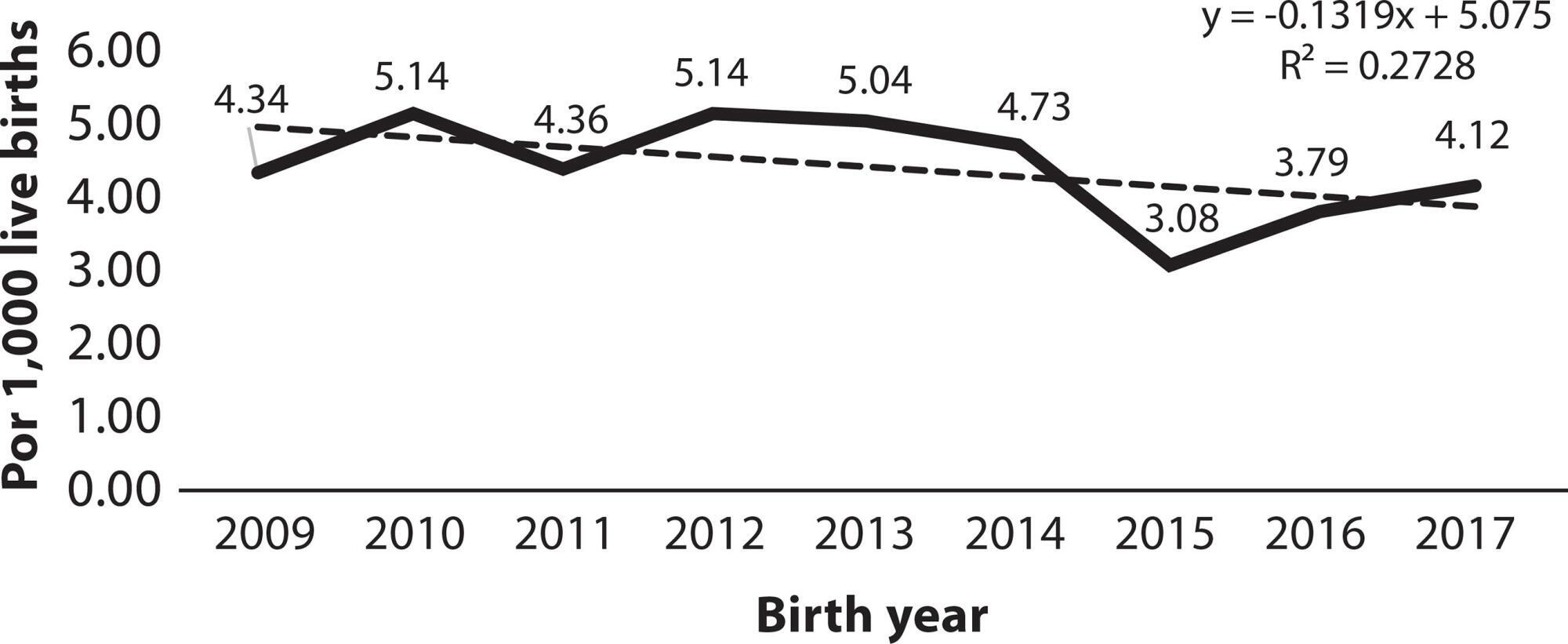
Search
Search in:
Nuvem de Tags
Adolescente (85) Atenção Primária à Saúde (239) COVID-19 (91) Criança (91) Cuidados de Enfermagem (269) Educação em Enfermagem (151) Educação em Saúde (139) Enfermagem (930) Enfermagem Pediátrica (86) Estudantes de Enfermagem (77) Estudos de Validação (131) Família (87) Idoso (208) Promoção da Saúde (99) Qualidade de Vida (104) Saúde do Trabalhador (86) Saúde Mental (145) Saúde Pública (82) Segurança do Paciente (150) Tecnologia Educacional (100)



